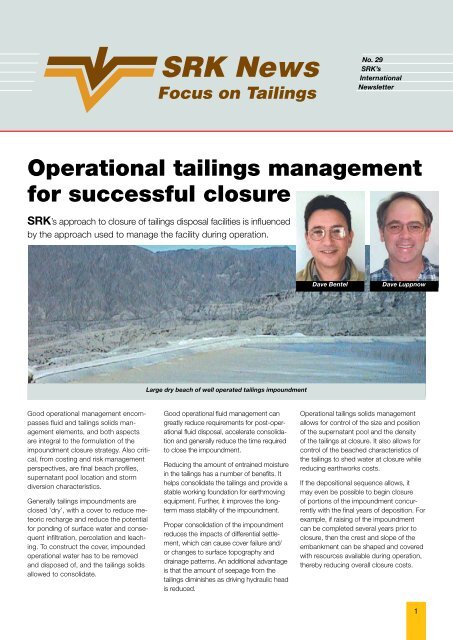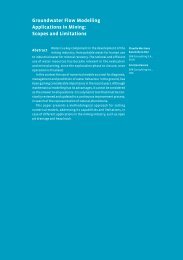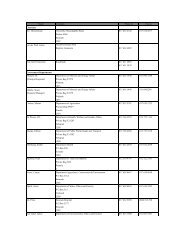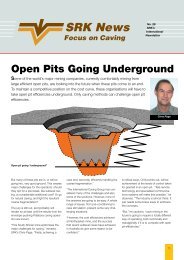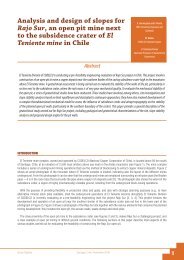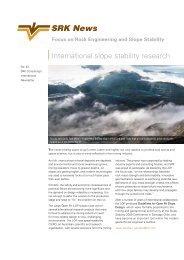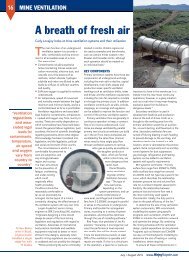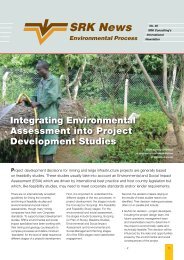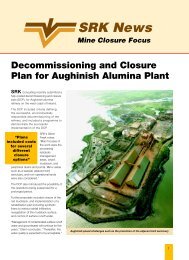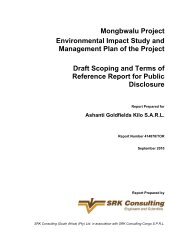Operational tailings management for successful ... - SRK Consulting
Operational tailings management for successful ... - SRK Consulting
Operational tailings management for successful ... - SRK Consulting
Create successful ePaper yourself
Turn your PDF publications into a flip-book with our unique Google optimized e-Paper software.
Good operational <strong>management</strong> encompasses<br />
fluid and <strong>tailings</strong> solids <strong>management</strong><br />
elements, and both aspects<br />
are integral to the <strong>for</strong>mulation of the<br />
impoundment closure strategy. Also critical,<br />
from costing and risk <strong>management</strong><br />
perspectives, are final beach profiles,<br />
supernatant pool location and storm<br />
diversion characteristics.<br />
Generally <strong>tailings</strong> impoundments are<br />
closed ‘dry’, with a cover to reduce meteoric<br />
recharge and reduce the potential<br />
<strong>for</strong> ponding of surface water and consequent<br />
infiltration, percolation and leaching.<br />
To construct the cover, impounded<br />
operational water has to be removed<br />
and disposed of, and the <strong>tailings</strong> solids<br />
allowed to consolidate.<br />
Focus on Tailings<br />
<strong>Operational</strong> <strong>tailings</strong> <strong>management</strong><br />
<strong>for</strong> <strong>successful</strong> closure<br />
<strong>SRK</strong>’s approach to closure of <strong>tailings</strong> disposal facilities is influenced<br />
by the approach used to manage the facility during operation.<br />
Large dry beach of well operated <strong>tailings</strong> impoundment<br />
Good operational fluid <strong>management</strong> can<br />
greatly reduce requirements <strong>for</strong> post-operational<br />
fluid disposal, accelerate consolidation<br />
and generally reduce the time required<br />
to close the impoundment.<br />
Reducing the amount of entrained moisture<br />
in the <strong>tailings</strong> has a number of benefits. It<br />
helps consolidate the <strong>tailings</strong> and provide a<br />
stable working foundation <strong>for</strong> earthmoving<br />
equipment. Further, it improves the longterm<br />
mass stability of the impoundment.<br />
Proper consolidation of the impoundment<br />
reduces the impacts of differential settlement,<br />
which can cause cover failure and/<br />
or changes to surface topography and<br />
drainage patterns. An additional advantage<br />
is that the amount of seepage from the<br />
<strong>tailings</strong> diminishes as driving hydraulic head<br />
is reduced.<br />
No. 29<br />
<strong>SRK</strong>’s<br />
International<br />
Newsletter<br />
Dave Bentel Dave Luppnow<br />
<strong>Operational</strong> <strong>tailings</strong> solids <strong>management</strong><br />
allows <strong>for</strong> control of the size and position<br />
of the supernatant pool and the density<br />
of the <strong>tailings</strong> at closure. It also allows <strong>for</strong><br />
control of the beached characteristics of<br />
the <strong>tailings</strong> to shed water at closure while<br />
reducing earthworks costs.<br />
If the depositional sequence allows, it<br />
may even be possible to begin closure<br />
of portions of the impoundment concurrently<br />
with the final years of deposition. For<br />
example, if raising of the impoundment<br />
can be completed several years prior to<br />
closure, then the crest and slope of the<br />
embankment can be shaped and covered<br />
with resources available during operation,<br />
thereby reducing overall closure costs.<br />
1
Introducing<br />
risk assessment<br />
specialist<br />
Tatyana Alexieva<br />
2<br />
Tatyana Alexieva<br />
As leader of the Risk Assessment Initiative<br />
of our Denver practice, Tatyana Alexieva<br />
is focused on satisfying the growing<br />
need <strong>for</strong> evaluation of the economic,<br />
engineering and environmental risks of<br />
mining projects.<br />
With a strong background in conducting<br />
static and dynamic stability analyses,<br />
seepage analyses, dam break studies,<br />
flow slide analyses, numerical modeling<br />
and settlement analyses, Tatyana has<br />
carried out many investigations, site<br />
selection, design, monitoring, and supervision<br />
<strong>for</strong> <strong>tailings</strong> and waste disposal<br />
projects around the world.<br />
Over the years Tatyana has managed<br />
to integrate her knowledge of mining<br />
with her risk analysis skills in conducting<br />
failure modes and effects analyses<br />
to evaluate the range of risks associated<br />
with mining and industrial site operations.<br />
Some of her recent projects include a risk<br />
assessment <strong>for</strong> a <strong>tailings</strong> storage facility<br />
in Indonesia to assist in the selection of a<br />
closure option. In Northern Canada, she<br />
has completed a comparative study of<br />
the risks associated with a range of remedial<br />
options <strong>for</strong> an underground mine.<br />
And, in New Caledonia, she has carried<br />
out a failure modes and effects analysis<br />
required <strong>for</strong> the permitting of a new <strong>tailings</strong><br />
storage facility.<br />
Disposal system <strong>for</strong> Corridor Sands<br />
Ken Mercer<br />
Based on its international track record<br />
<strong>for</strong> innovative and cost effective solutions,<br />
<strong>SRK</strong> was commissioned to develop a<br />
disposal system to handle both coarse<br />
and fine materials from the processing<br />
plant at the Corridor Sands Heavy Mineral<br />
Sands Project near the town of Chibutu,<br />
Mozambique.<br />
The Corridor Sands reserves are the<br />
world’s largest, and made up of approximately<br />
10 individual ‘deposits’. Open-pit<br />
dry mining will commence in a high grade<br />
section within Deposit 1 known as the<br />
West Orebody, which has an estimated<br />
life-of-mine of 20 years.<br />
The principal philosophy of disposal was<br />
to use separate disposal whereby coarse<br />
<strong>tailings</strong> are returned into the pit and fines<br />
slurry is disposed of on a <strong>tailings</strong> storage<br />
facility. Composite <strong>tailings</strong> (blended<br />
coarse/fines) disposal alternatives were<br />
also investigated.
Corridor Sands Tailings Storage Facility<br />
“For the <strong>tailings</strong> storage facility,” explains<br />
<strong>SRK</strong>’s Ken Mercer,”a configuration which<br />
uses a thickened slurry (paste) central<br />
discharge system with an outer impoundment<br />
wall was chosen. The dam has been<br />
designed to receive thickened slurry centrally<br />
discharged via risers situated within<br />
the drying basin of the dam.<br />
“Some 195-million (dry) tons of fines/<br />
coarse material will be deposited into the<br />
dam over the 20 years,” Ken continues.<br />
cropped version<br />
of site plan<br />
to come<br />
“The fines will require a storage volume of<br />
168-million m 3 and an evaporation area of<br />
12.5 km 2. .”<br />
Part of the design was undertaken with<br />
the aid of Gemcom software. Simulations<br />
were used to ensure that the required<br />
volumes of material generated could be<br />
accommodated, given limiting criteria<br />
such as adequate pit floor areas, safety<br />
and water handling requirements.<br />
Benefits of dry<br />
<strong>tailings</strong> disposal<br />
Dry <strong>tailings</strong> disposal is the most waterefficient<br />
waste <strong>management</strong> system and<br />
should be considered <strong>for</strong> both existing<br />
and all new mining projects. To achieve<br />
real cost benefits, it is necessary to<br />
integrate the design of process plant with<br />
that of <strong>tailings</strong> disposal while giving consideration<br />
to all design aspects, from site<br />
selection to closure of <strong>tailings</strong> impoundments.<br />
That’s the view of <strong>SRK</strong> director Adriaan<br />
Meintjes, who recently published a paper<br />
on waste <strong>management</strong> in the South<br />
African mining industry, with special<br />
reference to the advantages of dry <strong>tailings</strong><br />
disposal. In the document,<br />
Adriaan discusses the geotechnical<br />
properties of <strong>tailings</strong><br />
and shows how water savings<br />
can be made and groundwater<br />
pollution reduced by changing<br />
the <strong>tailings</strong> from wet slurry into<br />
a dry product.<br />
Key drivers <strong>for</strong> Adriaan’s focus<br />
on this subject include the<br />
Adriaan Meintjes<br />
long-term imperative to consider<br />
innovative methods <strong>for</strong><br />
water savings, in response to both the<br />
requirements of South Africa’s new Water<br />
Act and, more importantly, the need <strong>for</strong><br />
mines to attain a competitive advantage<br />
in terms of water use.<br />
“Another key objective is to limit ground<br />
and groundwater pollution,” Adriaan<br />
remarks, “to ensure water sources are<br />
not contaminated and are available <strong>for</strong> all<br />
potential users. In the case of dry <strong>tailings</strong>,<br />
seepage of water from <strong>tailings</strong> impoundments<br />
to groundwater is limited to available<br />
supernatant water. Surface <strong>management</strong><br />
of rainwater on impoundments can<br />
be engineered to limit ingress of water<br />
and reduce available supernatant water<br />
in <strong>tailings</strong> dams.<br />
“The attendant benefits are relevant to<br />
not just South Africa but also to other<br />
regions where water is scarce and environmental<br />
per<strong>for</strong>mance is critical.”<br />
To obtain a copy of Adriaan’s paper, “Dry<br />
Tailings Disposal – Increased Production<br />
& Potential Water Savings”, contact him<br />
at ameintjes@srk.co.za.<br />
3
<strong>SRK</strong> consultant<br />
profile: Pepe<br />
Moreno<br />
We are delighted to welcome Pepe<br />
Moreno, a respected Peruvian geotechnical<br />
engineer with over 11 years<br />
of experience in mining, infrastructure,<br />
transportation and natural gas projects,<br />
to our team.<br />
As Senior Geotechnical Engineer in the<br />
Lima office, Pepe leads the development<br />
of <strong>tailings</strong> and geotechnical projects in<br />
Peru, combining<br />
<strong>SRK</strong>’s worldwide<br />
experience with<br />
his knowledge of<br />
local engineering<br />
practice.<br />
Pepe says: “Until<br />
recently, mining<br />
operations in<br />
Peru have usually<br />
disposed their<br />
<strong>tailings</strong> with-<br />
Pepe Moreno<br />
out taking into<br />
account safety<br />
and environmental issues. Furthermore,<br />
mining projects are often located in<br />
steep terrain at high elevations, imposing<br />
additional constraints on typical <strong>tailings</strong><br />
disposal arrangements.<br />
Since the 1990s, the Peruvian government<br />
has placed more emphasis on<br />
<strong>tailings</strong> disposal, dictating strong environmental<br />
and safety requirements that<br />
obliged every mine to present a revised<br />
plan <strong>for</strong> their <strong>tailings</strong> disposal program.<br />
Some mining companies have been<br />
<strong>for</strong>ced to modify the current configuration<br />
of their <strong>tailings</strong> dams or to close those<br />
that cannot adapt to the new standards.<br />
This is a challenging opportunity <strong>for</strong> <strong>SRK</strong><br />
to provide engineering services and solutions<br />
that meet engineering and environmental<br />
goals, introduce new technology<br />
and help clients to improve their <strong>tailings</strong><br />
<strong>management</strong> systems while maintaining<br />
environmental compliance and profitable<br />
operations.”<br />
4<br />
Innovative dewatering plan <strong>for</strong><br />
uranium <strong>tailings</strong> impoundment<br />
<strong>SRK</strong> was retained by Pricewaterhouse<br />
Coopers to develop a dewatering plan <strong>for</strong><br />
the Atlas Moab uranium <strong>tailings</strong> impoundment<br />
in preparation <strong>for</strong> closure of the site.<br />
The project was controversial due to its location<br />
on the banks of the Colorado River,<br />
just upstream of the Grand Canyon.<br />
The unlined impoundment was used<br />
from 1956 to 1984, and contains some<br />
13-million tons of <strong>tailings</strong>. The closure plan<br />
proposed to cap the impoundment with a<br />
soil cover, and dewatering was necessary<br />
to minimise the amount of water entering<br />
the groundwater through the base of the<br />
impoundment during cover placement.<br />
<strong>SRK</strong> conducted geotechnical and hydrogeological<br />
investigations of the <strong>tailings</strong> to<br />
develop options <strong>for</strong> dewatering the pile.<br />
There had also been controversy over the<br />
geochemical content of the <strong>tailings</strong> pile,<br />
which had never been thoroughly examined.<br />
A geochemical investigation of the<br />
<strong>tailings</strong> solids and porewaters was also<br />
The Atlas Uranium Mill site<br />
conducted to determine what contaminants<br />
were contained within the pile.<br />
A large portion of the <strong>tailings</strong> were found<br />
to have a consistency similar to toothpaste,<br />
with low conductivity. Vertical wick<br />
drains were selected as the best option to<br />
dewater this material.<br />
“Wick drains are corrugated strips of<br />
plastic covered with a mesh to filter sediment,”<br />
explains Tracy Delaney. “Under the<br />
pressure of the soil cover, water is <strong>for</strong>ced<br />
up the wicks and onto the surface of the<br />
pile where it can evaporate.<br />
“Wick installation partly overlapped with<br />
cover placement, so that in some places<br />
wicks were installed in areas where a surcharge<br />
was already in effect. The effectiveness<br />
of the wicks was seen immediately,<br />
with water ponding on the pile surface.”<br />
Tracy Delaney
Cam Scott<br />
<strong>SRK</strong> <strong>Consulting</strong> completed the<br />
feasibility study <strong>for</strong> the Jericho diamond<br />
project in Nunavut, Canada’s newest<br />
Territory, in June 2000 on behalf of<br />
Tahera Corporation.<br />
The project is located at approximately<br />
65.5°N latitude, in a zone of continuous<br />
permafrost. Kimberlite will be processed<br />
on site in a 50 tph plant. Coarse <strong>tailings</strong>,<br />
representing approximately 85% of the<br />
<strong>tailings</strong> product, will be dewatered,<br />
trucked and dumped in a pile adjacent<br />
to the plant site. Fine <strong>tailings</strong>, referred to<br />
as processed kimberlite, will be pumped<br />
as a slurry to a containment area (PKCA)<br />
situated within 1 km of the plant site.<br />
A long, shallow lake with a very small<br />
catchment and marginal fish habitat<br />
was selected <strong>for</strong> PKCA development.<br />
The lake proposed <strong>for</strong> use as the PKCA<br />
Diamond <strong>tailings</strong><br />
disposal in a northern<br />
Canadian environment<br />
Confinement within the lake will be<br />
provided by a series of low dams and<br />
dikes. One or, possibly, two internal<br />
dikes will be used to develop cells.<br />
Deposition to the <strong>tailings</strong> cells will be<br />
cycled in a way that maximises the<br />
thawing of <strong>tailings</strong> deposited during<br />
winter and facilitates discharge of the<br />
maximum amount of water from the<br />
PKCA during each summer ‘window’.<br />
<strong>SRK</strong>’s Cam Scott says: “The quality of<br />
the <strong>tailings</strong> supernatant is expected to<br />
be quite good, but in the event it does<br />
not meet discharge criteria, a variety of<br />
alternatives are available.”<br />
Commercial diamond production may<br />
commence as early as 2003, and the life<br />
of mine is approximately eight years.<br />
Jericho pit area<br />
Caribou near the camp<br />
Northeast view over project area<br />
5
Risk assessment<br />
& audit of <strong>tailings</strong><br />
dams in Zimbabwe<br />
Ed Matinhari Danie Venter<br />
In the 1999 – 2000 rainy season persistent<br />
heavy rains, including the flooding<br />
and destruction caused by Cyclone Eline,<br />
prompted the mining sector in Zimbabwe<br />
to review the safety and risk of failure of<br />
<strong>tailings</strong> dams.<br />
This move was in line with the mining<br />
sector’s desire to attain a high standard of<br />
safety and environmental <strong>management</strong>.<br />
As part of this ef<strong>for</strong>t, <strong>SRK</strong> recently completed<br />
a technical risk assessment and audit of<br />
the <strong>tailings</strong> dams at the Mimosa, Railway<br />
Block and Peak Mines and the Kwekwe<br />
Ferrochrome Smelter of ZIMASCO. The<br />
recommendations made in the report submitted<br />
by <strong>SRK</strong>’s Ed Matinhari and Danie<br />
Venter are currently being implemented by<br />
the client.<br />
Ed, buoyed by ZIMASCO’s appreciation<br />
of the team’s ef<strong>for</strong>ts, notes that: “Tailings<br />
dams are designed to be operated and developed<br />
within a certain set of parameters,<br />
to ensure stability and long term integrity.<br />
“It is essential, there<strong>for</strong>e, to monitor certain<br />
per<strong>for</strong>mance criteria to ensure compliance<br />
with the design or allow timely remedial<br />
action. To ensure safe, economic, efficient<br />
and environmentally responsible disposal of<br />
<strong>tailings</strong>, it is necessary to manage, operate<br />
and monitor by design and not by chance.”<br />
<strong>SRK</strong> is now anticipating installing piezometric<br />
monitoring systems at ZIMASCO’s<br />
<strong>tailings</strong> dams. Safety monitoring will be integrated<br />
with the company’s environmental<br />
<strong>management</strong> programme to ensure compliance<br />
with the new Zimbabwe National<br />
Water Authority (ZINWA) Water Act and all<br />
other legislation.<br />
6<br />
Monitoring of <strong>tailings</strong> facilities offers inv<br />
Implementation of monitoring<br />
and <strong>management</strong> reduces<br />
the risk of failure of <strong>tailings</strong><br />
disposal facilities and provides<br />
a system by which<br />
minor faults, which could lead to possible<br />
failure, are identified and remediated at<br />
an early stage.<br />
That’s the view of <strong>SRK</strong>’s Johan Boshoff,<br />
whose wide-ranging project experience<br />
has caused him to conclude that<br />
Johan Boshoff<br />
the monitoring of <strong>tailings</strong><br />
disposal facilities provides<br />
an invaluable ‘early warning<br />
system’ to guard against<br />
possible failure of the impoundment<br />
and to ensure<br />
operational efficiency. Conversely, a lack<br />
of adequate monitoring, and failure to<br />
achieve legislative or regulatory compliance,<br />
can cause a <strong>tailings</strong> disposal<br />
facility to fail.
aluable ‘early warning system’<br />
Continuous drainage installation as part of operation<br />
Inspections, monitoring and dam safety<br />
observations are conducted through<br />
daily routine inspections and observations<br />
during dam operations, monthly<br />
inspections and meetings where all areas<br />
of concern are tabled and attended<br />
to timeously. Also important are quarterly<br />
inspections and <strong>for</strong>mal meetings attended<br />
by mine <strong>management</strong>, representation<br />
from the <strong>tailings</strong> dam operators and<br />
personnel from the mine’s appointed<br />
professional engineer.<br />
Aspects to be routinely monitored and<br />
recorded include freeboard, rate of rise,<br />
seepage and drainage, phreatic surface,<br />
penstock inlets and pool control, and<br />
groundwater. Other elements requiring<br />
scrutiny include return water dam,<br />
rainfall and evaporation recording, outer<br />
slopes and step-ins, catchment paddocks,<br />
solution trenches, and delivery/<br />
return water pump stations, pipelines<br />
and valves.<br />
slope angles & other aspects are monitored<br />
multi compartment <strong>tailings</strong> disposal<br />
supernatant pool within poolwall confines<br />
“Operation of a <strong>tailings</strong> disposal facility<br />
is the realisation of the design and any<br />
modifications to the design and the control<br />
of operation,” Johan continues. “An<br />
operating manual should be available<br />
and cover all points of operation. The<br />
monitoring operations and results should<br />
be incorporated into a <strong>for</strong>mal checklist<br />
so that no important aspect is omitted.<br />
This should include a contingency and<br />
emergency action plan in the event of<br />
any reasonably anticipated failure.”<br />
7
<strong>SRK</strong> consultant<br />
profile:<br />
Maritz Rykaart<br />
Maritz Rykaart joined the <strong>SRK</strong> Vancouver<br />
office in November 2001. Maritz<br />
brings over 9 years of mine closure and<br />
surface water <strong>management</strong> design and<br />
construction <strong>management</strong> experience,<br />
primarily from a geotechnical engineering<br />
viewpoint.<br />
Maritz currently provides specialist consulting<br />
services in mine closure, with special<br />
emphasis on waste rock dump, heap<br />
leach pad and <strong>tailings</strong> soil cover design<br />
and construction. A particular area of<br />
expertise of his is numerical modeling<br />
and calibration of soil cover per<strong>for</strong>mance<br />
using unsaturated soils theory. He has<br />
recently completed his Ph.D. in this area<br />
and has developed important new tools<br />
to help solve the complex water balance<br />
issues of soil covers in multi-dimensions.<br />
Maritz has applied his expertise in South<br />
Africa, Australia, Canada and the United<br />
States, both in consulting and construction,<br />
as well as in teaching courses in<br />
cover design.<br />
Maritz is currently working on a number<br />
of mine closure plans in Canada, Germany<br />
and Australia as well as providing<br />
senior review <strong>for</strong> cover design and<br />
numerical modeling <strong>for</strong> mines in the USA.<br />
8<br />
Maritz Rykaart<br />
Silvermines rehabilitation, Ireland<br />
View past mining subsidence to abandoned plant structures and <strong>tailings</strong> lagoon<br />
Snuggled against the Silvermines Mountain<br />
in County Tipperary is laid out a row<br />
of abandoned mines like a<br />
theme park on the history of<br />
mining in Ireland. The area<br />
has been exploited <strong>for</strong> over a<br />
thousand years <strong>for</strong> lead, silver,<br />
zinc, copper, barytes and<br />
sulphur. The mining remains<br />
range from shallow open-pits<br />
from the Middle Ages, through<br />
nineteenth century beam<br />
engine houses and furnaces,<br />
to extensive underground<br />
lead-zinc workings from the<br />
mid-twentieth century, finally ending with<br />
a large open-pit <strong>for</strong> baryte which closed<br />
in 1992.<br />
The old miners were not always tidy<br />
people, and the waste deposits scattered<br />
over the area have discharged <strong>tailings</strong> and<br />
heavy metals to streams and the atmosphere.<br />
Following problems with severe<br />
dust blows from one impoundment and<br />
cattle deaths caused by lead poisoning,<br />
the Department of Marine and Natural<br />
Resources undertook to develop a remedial<br />
or <strong>management</strong> plan <strong>for</strong> the area, and<br />
Ian Brackley<br />
appointed <strong>SRK</strong> to carry out a study and<br />
prepare conceptual designs. Apart from<br />
the obvious problems related<br />
to <strong>tailings</strong>, mine workings and<br />
plant structures, it was recognised<br />
that the mining heritage<br />
of the area is an important<br />
national asset, and must be<br />
conserved and made accessible<br />
as part of the overall<br />
plan. The concerns of the<br />
local community and other<br />
interested parties was also an<br />
important factor.<br />
<strong>SRK</strong> <strong>for</strong>med a multi-disciplinary<br />
team, including internationally-recognised<br />
experts, to develop a detailed integrated<br />
plan including the removal of waste from<br />
some areas and its consolidation on a single<br />
site, as well as the establishment of wetland<br />
areas to improve the quality of water discharges.<br />
A risk-based approach was used<br />
to assist in deciding priorities <strong>for</strong> remedial<br />
works on the basis of urgency and cost.<br />
Implementation of the proposed works<br />
after approval in 2002, will restore the area<br />
to the community and open up the rich<br />
mining heritage to visitors.
Drainage system <strong>for</strong> Missouri’s Brushy Creek Mine<br />
Safety, integrity and<br />
per<strong>for</strong>mance of the Brushy<br />
Creek <strong>tailings</strong> dam in<br />
Missouri’s Mark Twain<br />
National Forest have been<br />
significantly improved by an<br />
<strong>SRK</strong>-designed and installed<br />
horizontal drainage system.<br />
Rob Dorey<br />
The impoundment is associated<br />
with the Brushy<br />
Creek Mine & Mill, operated by the Doe<br />
Run Company, and consists of a cycloned<br />
sand embankment with a sloping slimes<br />
and whole <strong>tailings</strong> beach. Throughout<br />
the dam’s life, maintenance activities<br />
have been carried out to mitigate erosion<br />
related to elevated seepage levels in the<br />
toe area. Seepage has historically been<br />
related to the level and proximity<br />
of the free water pond to<br />
the upstream edge of the sand<br />
embankment.<br />
Elevated pond level in the fall<br />
of 2000 suggested that high<br />
seepage and increased erosion<br />
of the sand would occur in<br />
2001.<br />
As an effective method of<br />
draining the sands in the toe area, <strong>SRK</strong><br />
analysed and designed the installation of a<br />
series of horizontal drains.<br />
“The objective was to rapidly lower the<br />
phreatic surface within the dam,” say<br />
<strong>SRK</strong>’s Rob Dorey and Tim Coote.<br />
“The drains were drilled with a track-<br />
Tim Coote<br />
Brushy Creek Tailings Dam - Initial drain flow (DH-1) of 35 GPM<br />
mounted rig using a conventional tricone<br />
wash-drilling method to advance the holes<br />
to the target depth.”<br />
The seven drains, totaling 2,370 lineal feet,<br />
encountered a peak total flow in excess of<br />
200 gpm. Up to 9 feet of draw-down were<br />
induced in the lower dam, and up to 3.5<br />
feet in mid-dam.<br />
“Areas of seepage and general wetness<br />
at the toe of the dam had begun to drop<br />
noticeably by the end of the drainage drilling<br />
work,” reports the <strong>SRK</strong> project team.<br />
“Overall, the potential <strong>for</strong> erosion resulting<br />
from the phreatic surface daylighting was<br />
significantly reduced.”<br />
9
Rate of rise optimisation <strong>for</strong> a platinum <strong>tailings</strong> dam<br />
A major client in the platinum<br />
industry intends to increase<br />
production at one of its mines<br />
at the earliest opportunity.<br />
<strong>SRK</strong> was appointed to determine<br />
the maximum allowable<br />
rate of rise on the <strong>tailings</strong><br />
dam.<br />
As a first step, an <strong>SRK</strong> team<br />
carried out a detailed site<br />
investigation and used the<br />
results in a stability assessment<br />
and advanced simulation modelling<br />
to determine the optimum rate of rise <strong>for</strong><br />
the current geotechnical parameters and<br />
monthly <strong>tailings</strong> production rates.<br />
<strong>SRK</strong>’s Johan Boshoff remarks: “A detailed<br />
geotechnical investigation was conducted<br />
to identify and characterise the material<br />
types present in the <strong>tailings</strong> dam and<br />
foundation and to provide in<strong>for</strong>mation on<br />
10<br />
Johan Boshoff<br />
Typical platinum <strong>tailings</strong> dam<br />
the variation in properties<br />
of the <strong>tailings</strong> material. The<br />
static stability of the <strong>tailings</strong><br />
dam and the dissipation of<br />
excess pore pressure under<br />
the increased rate of rise was<br />
evaluated through simulation<br />
modelling while the probability<br />
of failure was calculated using<br />
the point estimate method.<br />
The overall probability of<br />
failure of the <strong>tailings</strong> dam was<br />
determined by means of a<br />
fault-event tree.”<br />
Four independent primary (initiating) faults<br />
were identified that could result in a largescale<br />
failure of the dam. However, overall<br />
probability of loss of life and extensive<br />
damage to the downstream infrastructure<br />
resulting from a flow failure from the <strong>tailings</strong><br />
was calculated and found to be within<br />
acceptable limits.<br />
From the investigation it was found that<br />
the maximum allowable rate of rise on the<br />
<strong>tailings</strong> dam can be increased to above<br />
the current allowable rate of rise of 2.5m/<br />
yr.<br />
“The increased rate of rise will not impact<br />
negatively on operational issues such as<br />
deposition cycle times, drying times, access<br />
onto the <strong>tailings</strong> dam or installation<br />
of curtain drains,” Johan remarks, “though<br />
certain operational issues will have to be<br />
modified.<br />
“To contribute to the continuing safe and<br />
<strong>successful</strong> operation of the <strong>tailings</strong> dam<br />
as a result of the increased rate or rise, we<br />
proposed additional monitoring systems.<br />
These include the installation of observation<br />
well piezometers, bi-annual piezocone<br />
testing and establishment of survey pegs<br />
at strategic positions on the <strong>tailings</strong> dam.”
Feasibility study emphasises environmental <strong>management</strong><br />
Alive to the need to conserve the abundant<br />
and unique local flora, <strong>SRK</strong>’s recently<br />
completed feasibility study <strong>for</strong> the proposed<br />
Goro nickel mine in New Caledonia<br />
made particular provision <strong>for</strong> environmental<br />
<strong>management</strong>.<br />
The Goro concessions are located within<br />
the Massif du Sud, a large ultramafic<br />
outcropping that covers 25% of the island<br />
of New Caledonia. These are plateau type<br />
deposits consisting of residual, in-situ<br />
laterite and saprolite developed from peridotite<br />
bedrock.<br />
The owner, INCO, had investigated the<br />
deposits over a period of 20 years. Tapping<br />
<strong>SRK</strong>’s extensive international experience<br />
of mine feasibility projects, INCO<br />
retained the consultants to complete a<br />
comprehensive viability study<br />
covering geology and mine<br />
planning, water <strong>management</strong><br />
definition and conceptual<br />
design, <strong>tailings</strong> <strong>management</strong><br />
and conceptual design,<br />
closure and reclamation planning.<br />
Involving personnel from five<br />
countries to bring the best<br />
expertise available to this<br />
demanding project, <strong>SRK</strong><br />
developed a plan <strong>for</strong> a 20year<br />
mine life that will produce<br />
nickel at a rate of 120 Mlb per year. It is<br />
anticipated that mining and Ni and Co<br />
production will continue well beyond the<br />
20-year mine plan currently under development.<br />
Views from the INCO pilot plant<br />
Don Beesley<br />
The feasibility study was a<br />
12-month ef<strong>for</strong>t, and was<br />
completed in the first quarter<br />
of 2001.<br />
Fundamental principles <strong>for</strong><br />
designing the overburden<br />
and <strong>tailings</strong> <strong>management</strong><br />
facilities were established at<br />
the onset of the project, to<br />
ensure that impacts to the<br />
environment would be minimised<br />
and that the facilities<br />
would be designed to remain<br />
safe during the life of the project through<br />
decommissioning and closure.<br />
Stockpiles<br />
11
<strong>SRK</strong> consultant profile: Michel Noël<br />
Michel Noël joined <strong>SRK</strong>’s Vancouver<br />
office after spending four years with the<br />
research team on acid mine drainage at<br />
the Australian Nuclear Science and Technology<br />
Organisation in Sydney, Australia.<br />
His affiliation with ANSTO enabled Michel<br />
to develop an expertise in the unsaturated<br />
properties of soil and rock material, the<br />
design of soil covers, and the modelling of<br />
oxidation processes in <strong>tailings</strong> and waste<br />
rock.<br />
For more in<strong>for</strong>mation, contact us at: www.srk.com<br />
Australia Tel: (+61) (7) 3832-9999 Fax: (+61) (7) 3832-9330<br />
Canada Tel: (+1) (604) 681-4196 Fax: (+1) (604) 687-5532<br />
Chile Tel: (+56) (2) 269-0353 Fax: (+56) (2) 269-0322<br />
Peru Tel: (+51) (1) 242-6578 Fax: (+51) (1) 445-7616<br />
South Africa Tel: (+27) (11) 441-1111 Fax: (+27) (11) 880-8086<br />
Turkey Tel: (+90) (312) 442-3650 Fax: (+90) (312) 442-3805<br />
United Kingdom Tel: (+44) (29) 2034-8150 Fax: (+44) (29) 2034-8199<br />
USA Tel: (+1) (303) 985-1333 Fax: (+1) (303) 985-9947<br />
Zimbabwe Tel: (+263) (4) 49-6182 Fax: (+263) (4) 49-0144<br />
12<br />
Michel has a degree in civil engineering<br />
and a graduate degree in geotechnical<br />
engineering. His background includes<br />
more than fifteen years of experience in<br />
consulting and research, primarily on mine<br />
related projects. This includes periods as<br />
an environmental engineer at the Heath<br />
Steele Mines and as a geotechnical engineer<br />
with Geocon.<br />
Michel will be working in <strong>SRK</strong>’s Geo-Environmental<br />
Department, and will be apply-<br />
Michel Noël<br />
ing his skills to mine environmental, mine<br />
closure and acid mine drainage projects in<br />
Canada, U.S. and Australia.<br />
Michel’s background complements the<br />
expertise provided by Dr. Maritz Rykaart,<br />
who also joined <strong>SRK</strong> Vancouver recently.<br />
The two add significant depth to <strong>SRK</strong>’s<br />
capabilities, particularly in the area of soil<br />
cover design and modelling.<br />
Issue No. 29


